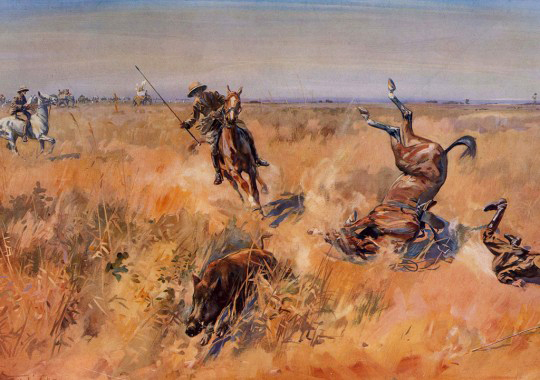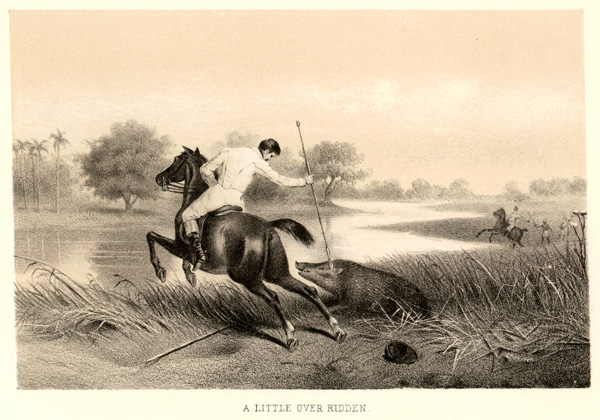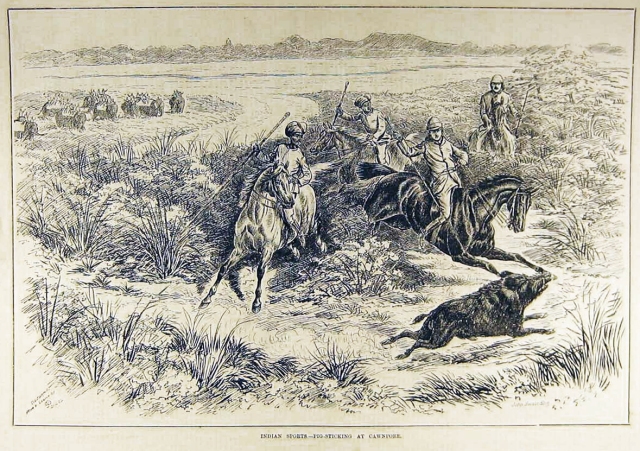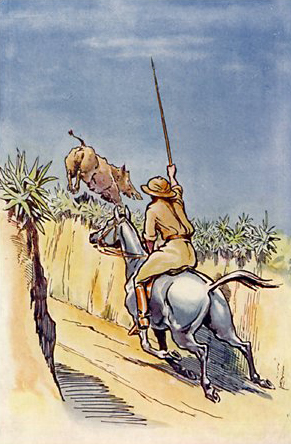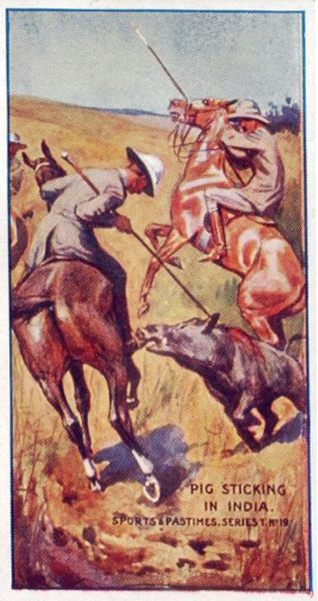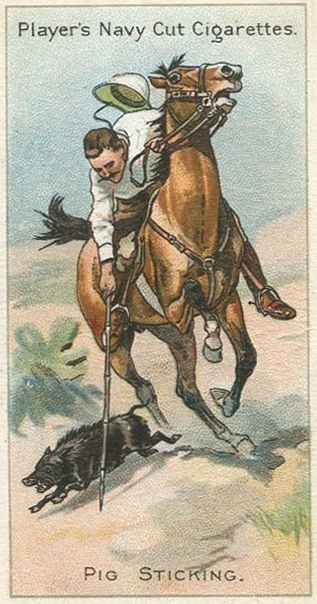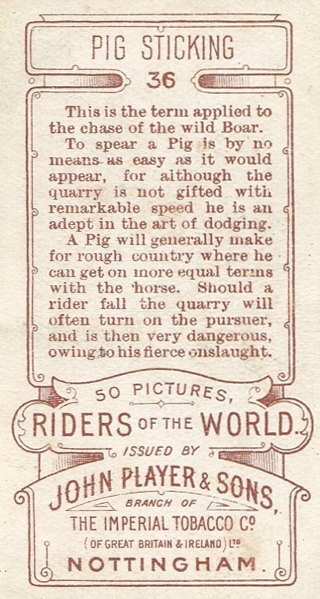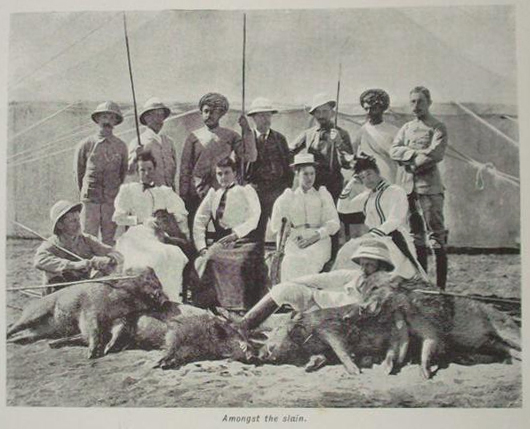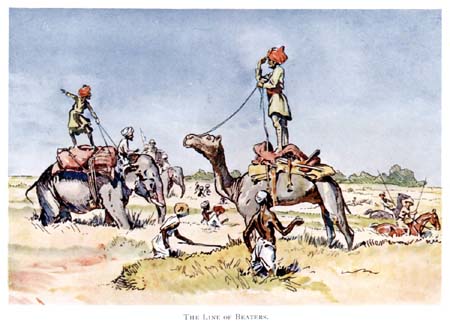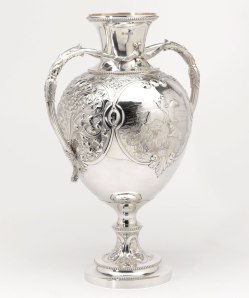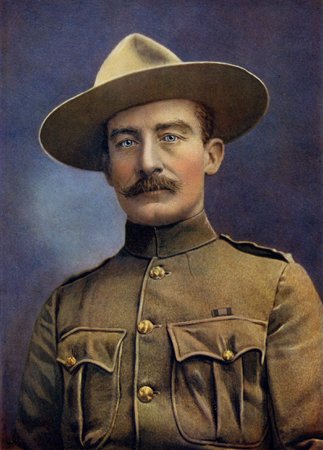Pigsticking1883
The Wonderful Pig of Knowledge!
I learned long ago never to wrestle with a pig.
You get dirty, and besides, the pig likes it.
--George Bernard Shaw
Pig-Sticking in India
 Hunting
wild boars on horseback was a popular recreation for British officers
in India during the Age of Empire. According to the 1911 Encyclopedia Britannica,
it was encouraged by military authorities as good training because "a
startled or angry wild boar is ... a desperate fighter [and therefore]
the pig-sticker must possess a good eye, a steady hand, a firm seat, a
cool head and a courageous heart."
Hunting
wild boars on horseback was a popular recreation for British officers
in India during the Age of Empire. According to the 1911 Encyclopedia Britannica,
it was encouraged by military authorities as good training because "a
startled or angry wild boar is ... a desperate fighter [and therefore]
the pig-sticker must possess a good eye, a steady hand, a firm seat, a
cool head and a courageous heart."The founder of scouting, Robert Baden-Powell, was a big believer in pig-sticking, even writing an 1889 book about it called Pigsticking or Hoghunting. In his Lessons from the Varsity of Life (1933), Baden-Powell wrote that "I never took the usual leave to the hills in hot weather because I could not tear myself away from the sport." Pig-stickers were apparently criticized for the barbarity of this sport, leading Baden-Powell to reply:
Try it before you judge. See how the horse enjoys it, see how the boar himself, mad with rage, rushes wholeheartedly into the scrap, see how you, with your temper thoroughly roused, enjoy the opportunity of wreaking it to the full. Yes, hog-hunting is a brutal sport—and yet I loved it, as I loved also the fine old fellow I fought against.There is a fascinating article about pig-sticking by William Livingston Alden that originally appeared in Harper's New Monthly Magazine, vol. 61, issue 366, June 1880. It notes that "For pig-sticking there are two requisites in addition to the pig—a fast, steady horse, and a good hog spear." You can find this essay reprinted here.
The image above, "Pig Sticking on the Churs of the Brahmapootra--Surprised by a Tiger," appeared in The Graphic in 1891. I found it here with other images from The Graphic and the Illustrated London News.
Pig Sticking
I was reading about polo in India and the
role played by the British military in bringing polo from India to
England, and thence to the United States, when I came across another
British sport in India that involved a spear rather than a mallet, and
an enraged boar rather than a ball.
Pig sticking certainly doesn’t have polo’s cachet, but for a time it had its own journal, Hog Hunters’ Annual, and books devoted to the subject, including Sir Robert Baden-Powell’s Pig-Sticking or Hog-Hunting: A Complete Account for Sportsmen and Others (1889), Reminiscences of Twenty Years’ Pigsticking in Bengal (1893) by “Raoul” and Modern Pig Sticking (1914) by Major A.E. Wardrop.
A watercolor by Snaffles
Pig sticking even had its own Super Bowl –
the Kadir Cup – its own toast – “To the Boar!” – and its own songs,
most probably sung after several toasts. A number of artists illustrated
the sport for magazines and prints, most notably Charles Johnson Payne
(1884-1967), who signed his sketches “Snaffles.” The sport thrived in
India from the early 1800s until just after World War II. Its essence
was described by Major General J.G. Elliott in his Field Sports in India 1800-1947:
“Armed with a
nine-foot lance, the pig-sticker rode a galloping horse in pursuit of
wild boar which had been flushed out of the bush by beaters. The aim was
to stick the boar immediately behind the shoulder, so that the spear
would pass through the lungs and out at the breast.”
The sporting aspect came from the marked
reluctance of the boar to cooperate. The boars of India grew up to five
feet in length and three feet at the shoulder; Elliott wrote of one bad
boy who measured 44 inches at the shoulder and weighed more than 400
pounds. Such boars ran as fast as a horse, could make a 90-degree turn
at a full gallop (a practice known as “jinking”), and came armed with
curved tusks up to 9 inches long, sharp teeth and a profoundly irritable
disposition. When unable to outrun its pursuer, the boar turned and
charged.
In the middle was the horse, who could be
cut, even killed, by the boar’s tusks. And once speared, boars were
known to struggle upwards on the lance to get to the wide-eyed man at
the end.
“The Pig Takes a Toss,” a sketch from the Kadir Cup of 1923 by Lionel Edwards (1878-1966)
The boar aside, the pursuit itself was
dangerous. Elliott notes, “The horse had to be able to remain upright
when galloping full tilt through thick grass six to nine feet high, over
ground as hard as rock, seamed with large and small nullahs
[steep, narrow watercourses, usually dry] and the occasional sunken
buffalo wallow… Old, disused wells, completely overgrown by long grass,
were a constant hazard… in 1890, a Colonel Napier fell into one and
broke his neck.”
Watercolor by Sir Robert Baden-Powell
Baden-Powell offered this advice to riders:
“So,
considering the extra dangers inherent in pig-sticking it would be well
for the beginner to cultivate what art there is in falling, for all
things are possible to the hog-hunter who knows how to fall. The main
thing is under all circumstances to keep hold of your reins, for three
reasons : first, because it is at least a nuisance to be left horseless
in the presence of an angry boar ; secondly, because it may sometimes
save you from being dragged, if your foot catches in the stirrup;
thirdly, because the act of hanging on to the reins often gives the body
a cant up at the critical part of the pitch and so saves a broken
collar bone.”
Cigarette trading cards
Pig stickers, much like polo players, sought horses suited to the task. Captain Scott-Cockburn wrote of his favorite mount:
“Carclew really
loved a hunt. At the cry ‘woh jata’ (there he goes) I could feel his
heart thumping between my legs; once a boar had been singled out he
would follow him as a greyhound will a hare. In the open he would place
me right to spear within a minute. In thick tamarisk or grass it was no
more necessary for me to steer him than in the open. Whenever we lost a
pig it was either in impenetrable thorn, or when the cover was over my
head. I think he must have accounted for a good third of the 500-odd
boar on which I got ‘first spear.’ In ten years’ hunting, he was never
cut by a pig nor missed his turn.”
“Tent clubs” served to organize the hunts, and their activities were reported in The Oriental Sporting Magazine.
The killing of female hogs was frowned upon, and pregnant sows always
received a pass. Any member of the Calcutta Tent Club who accidentally
killed a sow was fined 12 bottles of champagne.
Photo from
an 1895 magazine article; the only image I’ve ever seen with women, and
it could be me, but they don’t appear to be too pleased. And below, a
second image from the same article.
The beaters were the final, and indispensable, members of the cast. Elliott wrote:
“Barefoot, clad only in a loincloth and pagri
[turban], and carrying a stout pole, a hundred of them in line would
beat through the high grass until a rideable boar emerged with a savage
‘woof-woof’ from a thicket. And all for a few annas a day.
There was, however, another attraction. Fox hunting has been described
as the ‘unspeakable in pursuit of the uneatable,’ but pig sticking has
the edge as pork was considered a great delicacy by the beaters.”
“The Line of Beaters” by Sir Robert Baden-Powell
The day’s hunt, in a field where
temperatures might be over 100˚F in the shade, would end at mid-day with
a quick lunch, “plenty of cold beer,” and a long nap before an evening
visit to the horse lines and then dinner in the mess tent where the men
would talk about pig sticking.
The Kadir Cup
The sport had its competitive side. First
held in the 1870s, the Kadir Cup was a competition for “first spear” and
hosted more than 50 entrants annually. Groups of three were drawn and
when a pig was flushed the men galloped off, each trying to spear the
pig and draw first blood. The first to do so showed his spear to the
umpire and went into the next round. At day’s end, the winner received
the entry fees and with the money bought a replica of the trophy.
Lord Baden-Powell
The most famous winner of the Kadir Cup,
in 1883, was Sir Robert Baden-Powell, a Lieutenant-General in the
British Army in India and Africa, and the founder of the Boy Scout
movement. In a chapter on pig sticking in his autobiography, Lessons from the Varsity of Life (1933), he wrote:
“Yes,
hog-hunting is a brutal sport – and yet I loved it, as I loved also the
fine old fellow I fought against. I cannot pretend that I am not
inconsistent. But are many of us entirely consistent ? Do what we will
and say what we like, although we have a veneer of civilisation, the
primitive man’s instincts are still not far below the surface.”
Hog hunting in India came to an end after
World War II, as cavalry gave way to mechanized warfare and the British
departed. The sport is still pursued in other nations.
A particularly appropriate Snaffles sketch from Hog Hunters’ Annual
Pig-sticking in Morocco. Hunting 1888 antique
However, please note that the condition
of the item that you receive may differ slightly from that shown in the
image, which may have been taken from a different example of the print.
The strength of the impression and the degree to which the text/images
on the reverse side show through on the front may vary somewhat from
that shown. There may be some slight spotting, minor blemishes or light
offsettingThis is a folding item and there may be pinholes along the
centrefold. Virtually all antiquarian maps and prints are subject to
some normal aging due to use and time which is not obtrusive unless
otherwise stated. We offer a no questions asked return policy.
PROVENANCE: The Illustrated London News
